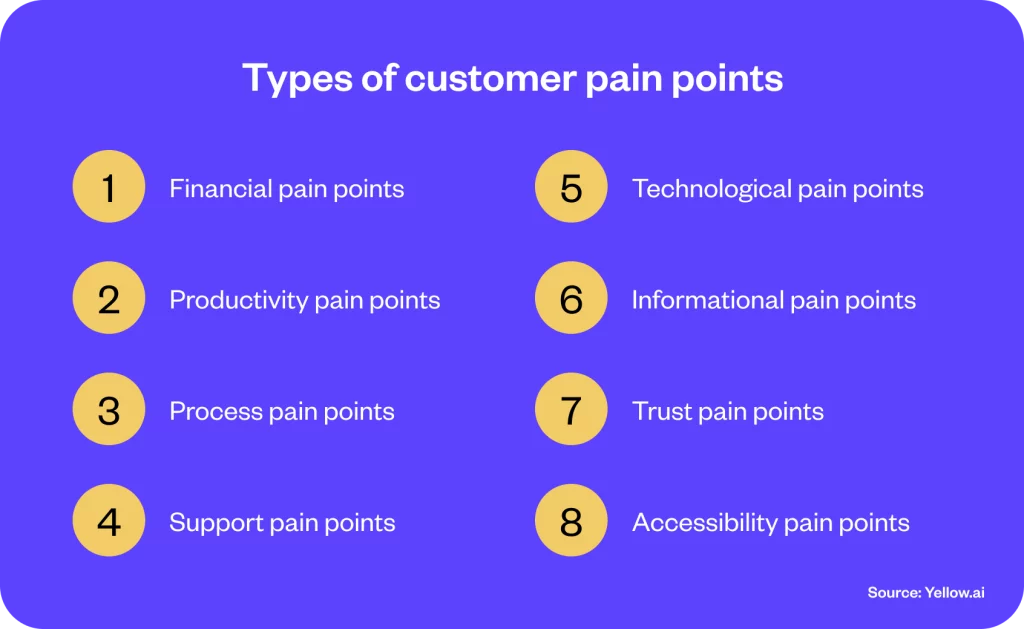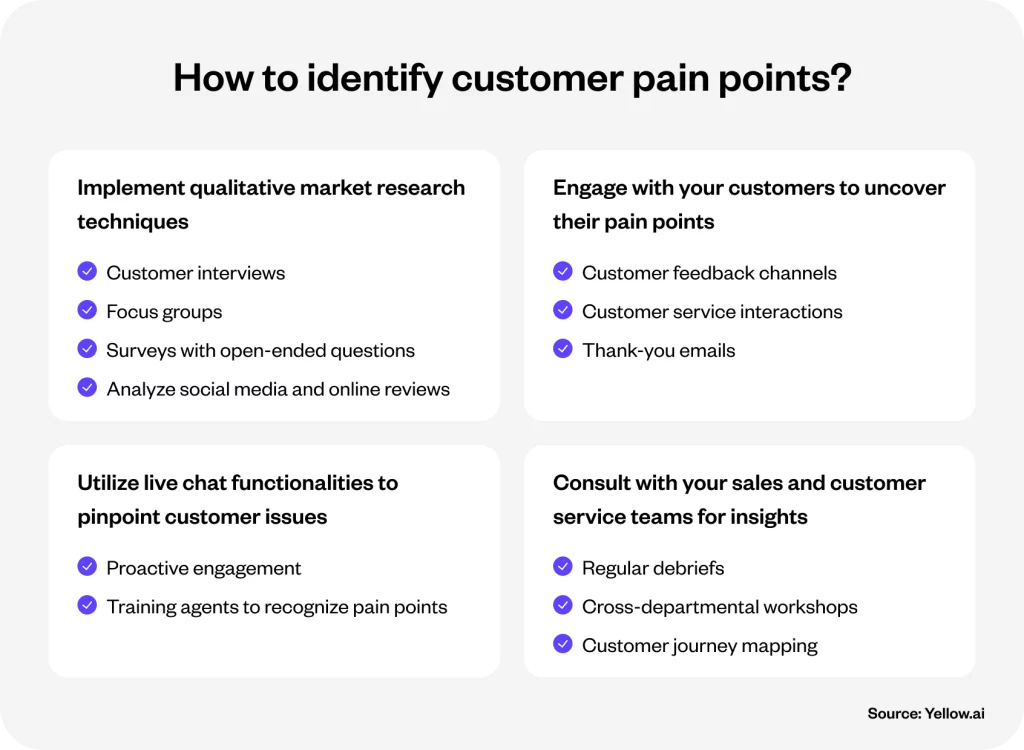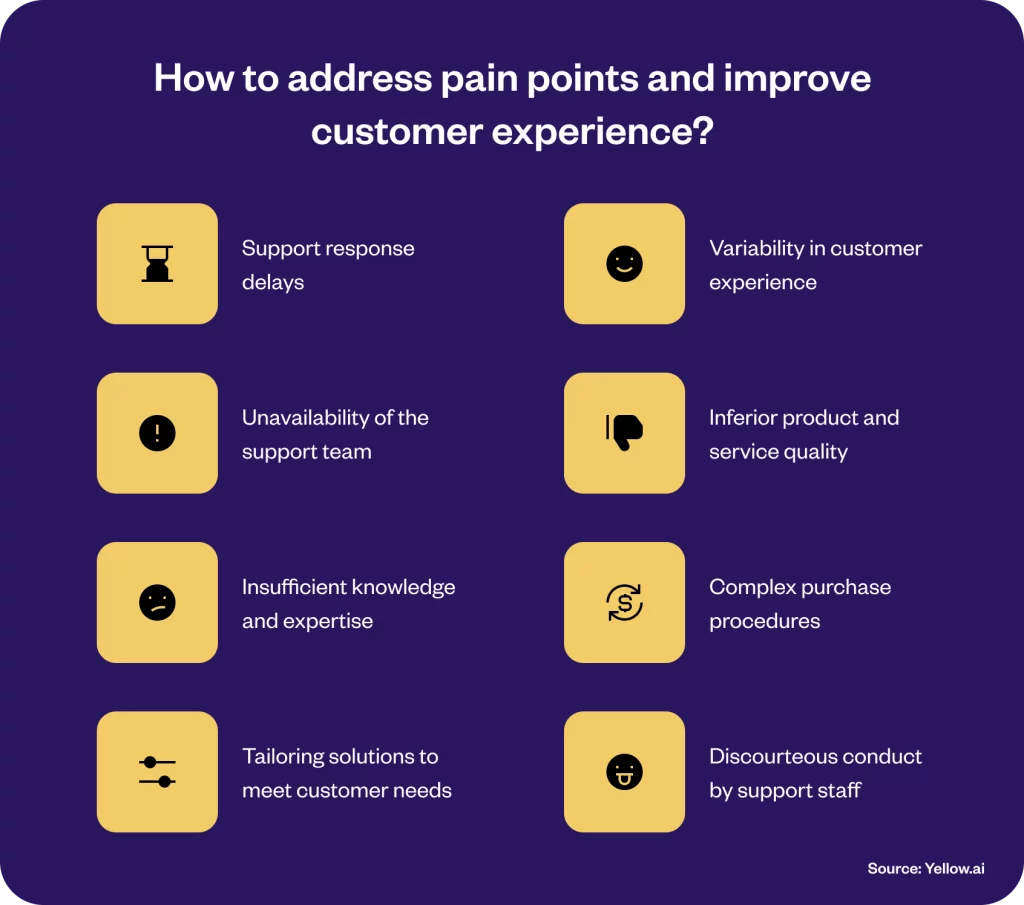Executive summary
Dive deep into the world of customer experience with our comprehensive guide on identifying and resolving customer pain points. Explore essential strategies for uncovering the hurdles that hamper customer satisfaction and loyalty, from understanding examples of pain points to mastering the art of identifying customer pain points. This blog promises to equip businesses with the insights needed to effectively tackle common customer pain points, enhancing overall customer satisfaction and driving success.
Ever hit a roadblock that made a simple task frustratingly complicated? That’s a pain point in action, and just like in life, your customers face them, too. Imagine this: 75% of businesses prioritize enhancing customer experience, recognizing that the path to loyalty is paved with more than just good intentions. It’s about understanding those moments that make customers think, “There’s got to be a better way.”
Remember, it is not about pointing fingers at problems but embracing a detective’s curiosity to uncover what really sticks in your customer’s craw. In a digital era where options are endless and patience is in short supply, missing out on resolving these pain points can send your customers into the welcoming arms of competitors. But here’s the kicker: with the right tools and a bit of savvy, identifying and smoothing out these rough spots can turn the casual shopper into your biggest fan.
Read on to explore the world of customer pain points. We will explain what they are, why they’re more than just hiccups in your service, and how, with a mix of empathy and strategy, you can turn potential pitfalls into opportunities for growth.
What are customer pain points?
In today’s bustling marketplace, understanding customer pain points is just like holding a compass in the vast ocean of business strategy. Simply put, customer pain points are the specific challenges, frustrations, or obstacles that customers face throughout their journey with a brand. Do not mistake them for minor inconveniences because they’re significant hurdles that can deter a customer’s path to satisfaction, loyalty, and advocacy. From the initial awareness stage to the point of purchase and beyond, every touchpoint holds the potential for pain points that can tarnish a brand’s reputation and bottom line.
Recognizing and addressing these pain points goes beyond just patching up a problem. It is about transforming challenges into opportunities for growth and differentiation. For businesses, the stakes are high. A pain point left unchecked is like a crack in a dam. It may initially look small, but it is potentially disastrous if ignored. It’s not just about losing a single sale; it’s about the ripple effect of dissatisfaction that can spread through word-of-mouth and social media, tarnishing your brand’s image in the collective consumer consciousness. In an era where customer expectations are sky-high and alternatives are just a click away, understanding and resolving customer pain points is imperative for staying competitive and relevant.
Types of customer pain points
It is crucial to understand that not all pain points are created equal. Each type reflects a distinct aspect of the customer journey, where friction points can lead to dissatisfaction. Let’s break down different types of customer pain points to shed light on where your business might be missing the mark.

1. Financial pain points:
The sting of spending often hits the hardest. These pain points arise when customers feel that the cost of a product or service outweighs its perceived value or strains their budget. Look for signals like:
- Unexpected fees at checkout that sour the final purchasing decision.
- High subscription or renewal prices causing customers to reconsider their choices.
- The necessity for frequent replacement upgrades inflates the long-term cost.
2. Productivity pain points:
For many, time is money! Customers notice it when your product or service slows them down. These pain points emerge when customers feel that interacting with your business or using your product is inefficient or cumbersome. Key indicators include:
- Processes that require unnecessary steps or prolonged effort.
- Tools or services that don’t integrate well with existing workflows, hindering seamless operation.
- A lack of automation for repetitive tasks, forcing manual intervention.
3. Process pain points:
Like a roadblock in a fast-moving lane, these pain points occur when bureaucratic or procedural hurdles make engaging with your business frustrating. Common issues involve:
- Complicated checkout or registration processes that test patience.
- Slow delivery or implementation timelines that delay gratification.
- A chaotic or unhelpful support center that complicates problem resolution.
4. Support pain points:
When help seems far away, customers feel it deeply. These points are marked by customer service interactions that leave much to be desired, including:
- Extended wait times for responses or resolutions.
- Failure to resolve issues effectively, necessitating repeat contacts.
- A lack of product or service knowledge from support staff, undermining confidence.
5. Technological pain points:
Glitches and bugs can be major roadblocks in our digital world. These pain points arise from technical issues with your product or service that prevent customers from achieving their goals, such as:
- Software crashes or hardware malfunctions that disrupt usage.
- Outdated technology that lags behind current standards, making the user experience feel archaic.
- Poor integration with other digital tools, creating silos rather than a seamless ecosystem.
6. Informational pain points:
Lost in translation? Customers encounter these pain points when they can’t find the information they need or when the information provided is confusing or misleading. It includes:
- Sparse product details or instructions, leaving users to figure things out on their own.
- Overwhelming or overly technical language that alienates rather than educates.
- Hard-to-find contact information or support resources, making it difficult to seek help.
7. Trust pain points:
The foundation of any customer relationship is trust, and when it’s lacking, it’s felt acutely. Trust issues may stem from:
- Past experiences of unmet expectations, eroding faith in promises made.
- Lack of transparency about product sourcing, pricing, or company policies.
- Perceived indifference to customer privacy or security, raising concerns over data handling.
8. Accessibility pain points:
Ensuring your business is accessible to all is not just good practice; it’s essential. These pain points emerge when customers find it difficult to access or use your products due to physical, technological, or situational barriers, such as:
- Websites, apps, or physical locations that are not user-friendly for individuals with disabilities.
- Limited language options that exclude non-native speakers.
- A lack of consideration for varied demographic or geographic needs, overlooking a portion of your potential market.
Interested in transforming your customer service?

How to identify customer pain points?
Identifying customer pain points requires keen observation, a deep understanding of your audience, and the right tools to uncover the truths that lie beneath the surface. Let’s explore the strategies that can highlight your customers’ challenges and how to tackle them effectively.

1. Implement qualitative market research techniques
Qualitative market research is about getting to the heart of what your customers truly need and want. It involves:
- Customer interviews: Have one-on-one conversations to explore their experiences in depth.
- Focus groups: Gather groups of customers to discuss their needs and frustrations, providing a broader perspective on common pain points.
- Surveys with open-ended questions: These can provide nuanced insights into customer attitudes and experiences.
- Analyze social media and online reviews: Customers often share their experiences and grievances online. Monitoring these platforms can reveal common pain points you might not be aware of.
2. Engage with your customers to uncover their pain points
It is vital to connect and engage with your customers. Only then can you get an understanding of their pain points. Create a two-way dialogue using the following tips:
- Customer feedback channels: Establish open lines of communication through feedback forms, social media, and direct emails. Encourage your customers to share their experiences.
- Customer service interactions: Analyze interactions with customer service to identify recurring issues or concerns.
- Thank-you emails: Following a purchase, ask customers for feedback on their buying experience to identify any friction points.
3. Utilize live chat functionalities to pinpoint customer issues
Live chat offers real-time engagement, allowing you to identify and address customer issues quickly. Implementing this effectively includes:
- Proactive engagement: Don’t wait for customers to reach out. Use live chat to ask them about their experience as they navigate your site.
- Training agents to recognize pain points: Ensure your live chat representatives are trained to identify pain points during their conversations.
4. Consult with your sales and customer service teams for insights
Leveraging internal knowledge is the best way to gain insights into your customer pain points. Here is what you can do:
- Regular debriefs: Hold frequent meetings with your sales and customer service teams to discuss common customer feedback and complaints.
- Cross-departmental workshops: These can help in understanding the full spectrum of customer pain points and brainstorming solutions together.
- Customer journey mapping: Collaborate with these teams to map out the customer journey, highlighting areas where customers face challenges.
How to address pain points and improve customer experience?
Addressing customer pain points is just like finding a key that unlocks a door to superior customer experience and loyalty. By focusing on these pain points, brands can significantly enhance their service delivery. It leads to happier customers and a more substantial business reputation. Below, we outline strategies to address common customer pain points, alongside the impact of each approach and tips for effective implementation.

1. Support response delays
Implementing real-time response mechanisms, such as live chat and chatbots, reduces wait times and increases customer satisfaction. A swift response can transform a potentially negative experience into a positive one and significantly boost customer satisfaction levels. Utilize automated responses for common queries and ensure your team is adequately staffed during peak hours to manage live interactions efficiently.
2. Variability in customer experience
Standardize service delivery across all touchpoints to ensure a consistent customer experience. Consistency builds trust and confidence in your brand, encouraging repeat business and customer loyalty. Regularly train your team on best practices and monitor all channels for quality assurance.
3. Unavailability of the support team
Extend support hours using a mix of live support and automated solutions like chatbots for 24/7 availability. Continuous availability addresses customer issues at their convenience, enhancing overall satisfaction and trust in your brand. Clearly communicate your support hours and use AI chatbots to handle after-hours inquiries.
4. Inferior product and service quality
Focus on continuous improvement based on customer feedback to enhance product and service quality. High-quality products and services lead to more satisfied customers, positive reviews, and repeat purchases. Implement a robust feedback loop with your R&D and service teams to quickly address quality issues.
5. Insufficient knowledge and expertise
Invest in ongoing training for your staff to ensure they possess the necessary product knowledge and skills. Well-informed staff can provide accurate information and solutions, reducing customer frustration and increasing confidence in your brand. Develop a knowledge base and encourage staff to regularly consult it and share insights with colleagues.
6. Complex purchase procedures
Simplify the buying process, reducing steps and unnecessary complexity at checkout. A streamlined purchase process minimizes cart abandonment and enhances the customer buying experience. Review your purchase flow from the customer’s perspective and eliminate any non-essential steps.
7. Tailoring solutions to meet customer needs
Customize your offerings to meet the specific needs of your customers. It shows that you understand and value their unique challenges. Personalized solutions significantly increase customer satisfaction and can turn customers into brand advocates. Use customer data to segment your audience and tailor services or products accordingly.
8. Discourteous conduct by support staff
Build a culture of empathy and respect within your customer service team to ensure all customer interactions are positive. Polite and empathetic service can diffuse potential conflicts and strengthen customer relationships, even when problems arise. Provide regular training on empathy and customer care, and recognize staff who exemplify these values.
How does Yellow.ai help address and solve customer pain points
Navigating through the customer experience landscape, it’s clear that addressing pain points effectively is a game changer. That is where Yellow.ai steps into the spotlight, equipped with cutting-edge technology designed to transform customer frustrations into triumphs. By integrating Yellow.ai’s dynamic AI-powered solutions, businesses can leapfrog common hurdles. It ensures a seamless, satisfying customer journey. Here’s how Yellow.ai aligns with the strategies we’ve discussed, showcasing a synergy that’s hard to overlook:
- Real-time engagement: Our state-of-the-art AI-powered chatbots and voice agents offer instant responses, reducing wait times and boosting customer satisfaction. With advanced natural language processing (NLP), these AI bots understand and resolve queries efficiently.
- Provide support across 35+ channels: Seamlessly integrate support across all digital platforms, courtesy of Yellow.ai’s sophisticated platform, ensuring consistent and cohesive customer experiences.
- 24/7 availability: With AI-driven chatbots, Yellow.ai guarantees round-the-clock support. It ensures help is always on hand, whenever and wherever it’s needed.
- Enhanced quality and insight: Leveraging AI and machine learning, Yellow.ai continuously learns from interactions. It enables businesses to improve product offerings and service quality based on real-time feedback.
- Knowledge empowerment: Empower your team with AI-backed knowledge bases. By doing so, you can ensure that they have all the information they need to resolve customer issues swiftly.
- Streamlined processes: Yellow.ai simplifies complex procedures, from purchase to support, ensuring a frictionless customer journey. Automate user-specific lifecycle campaigns to convert them at every touchpoint along the purchasing process with Yellow.ai User Lifecycle Optimizer, an AI-powered generative tool.
- Personalized, multilingual, and enhanced customer experience: Utilize Yellow.ai’s voice AI agents to tailor solutions and responses to individual customer needs. They can communicate in over 135 global languages and dialects. The combination of our Dynamic NLP with our Automatic Speech Recognition (ASR) technology allows for a more precise interpretation of user intent. It will enhance satisfaction and loyalty.
- Empathy at scale: With sentiment analysis, Yellow.ai bots understand customer emotions. It allows for responses that are not just timely but also empathetic and individualized.
Discover how Yellow.ai can revolutionize your customer service. Book a demo today and take the first step towards eradicating customer pain points with precision and empathy.
Success stories

Hyundai boosts revenue and improves customer service with AI automation
Explore how Yellow.ai’s automation led to ~1000 car sales, a 10% retail conversion rate, and over 1.4 million user impressions

Pelago reimagines customer experience with generative AI powered conversational AI agents
Within a mere six weeks of going live, Pelago not only onboarded over 5,000 users but also achieved a striking 50% deflection rate!
The final thoughts
The path to excellence in identifying and addressing customer pain points is paved with insight, innovation, and a touch of technology. In a marketplace that never sleeps, staying ahead means meeting and exceeding customer expectations. It turns potential pitfalls into pillars of success.
The future beckons with the promise of AI and machine learning shaping the way we understand and address customer needs. With tools like Yellow.ai, businesses are anticipating and obliterating pain points before they can even surface. It is a proactive approach that delights customers and also sets a new benchmark for what’s possible in customer experience.
Frequently asked questions (FAQs)
How can businesses identify customer pain points?
Businesses can identify customer pain points by employing a mix of qualitative market research, analyzing customer feedback across multiple channels, engaging directly with customers, and leveraging internal insights from sales and customer service teams. These strategies allow businesses to unearth the specific challenges their customers face, enabling targeted solutions.
What strategies can improve customer support response times?
To improve customer support response times, businesses can implement AI-powered chatbots for real-time engagement, optimize their staffing models to ensure availability during peak times and utilize customer service platforms that integrate across all communication channels for seamless support.
How can companies ensure a consistent customer experience across all channels?
Ensuring a consistent customer experience across all channels requires a robust omnichannel strategy, which includes integrating customer service platforms, standardizing service protocols, and training staff thoroughly to deliver uniform quality of service, regardless of the touchpoint.
What role does employee training play in addressing customer pain points?
Employee training is critical in equipping staff with the necessary knowledge and skills to address customer pain points effectively. Regular, comprehensive training ensures that team members stay updated on product developments, service protocols, and customer engagement techniques. It enables them to provide solutions that enhance customer satisfaction.
How can businesses turn customer pain points into opportunities?
Businesses can turn customer pain points into opportunities by closely analyzing these challenges to innovate their product offerings, service delivery, and customer engagement strategies. By addressing pain points proactively, businesses can improve customer satisfaction and loyalty and, ultimately, drive growth and differentiation in the market.

















